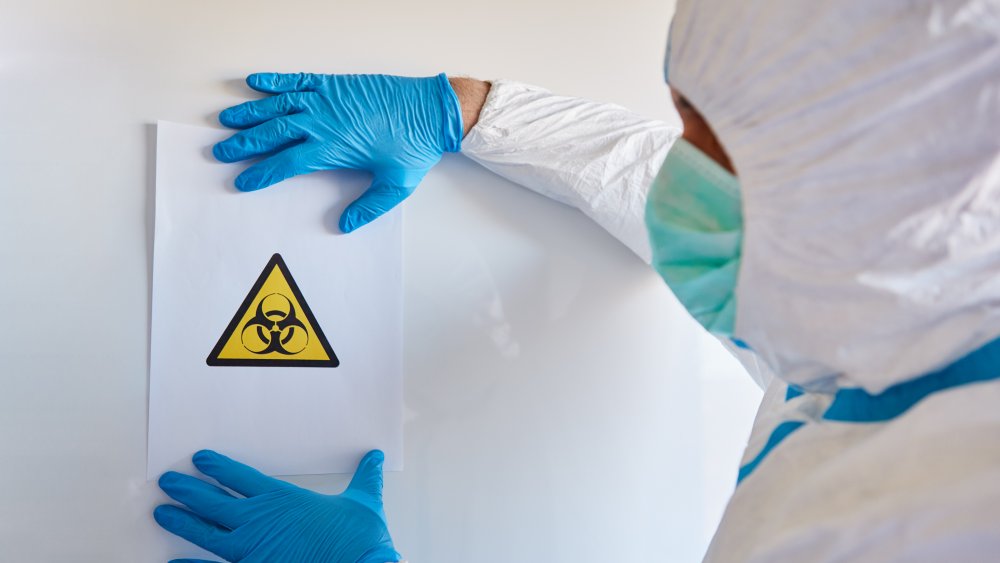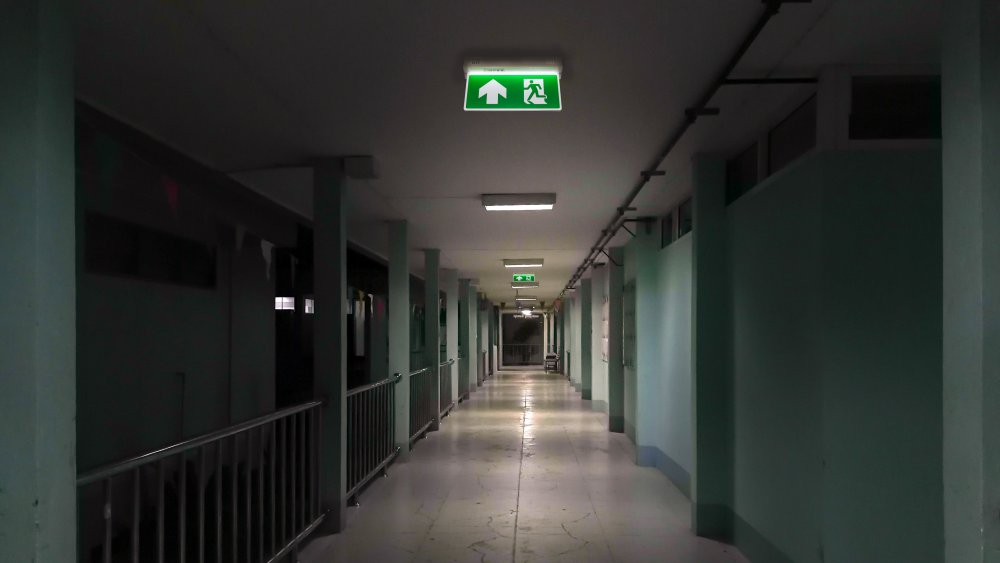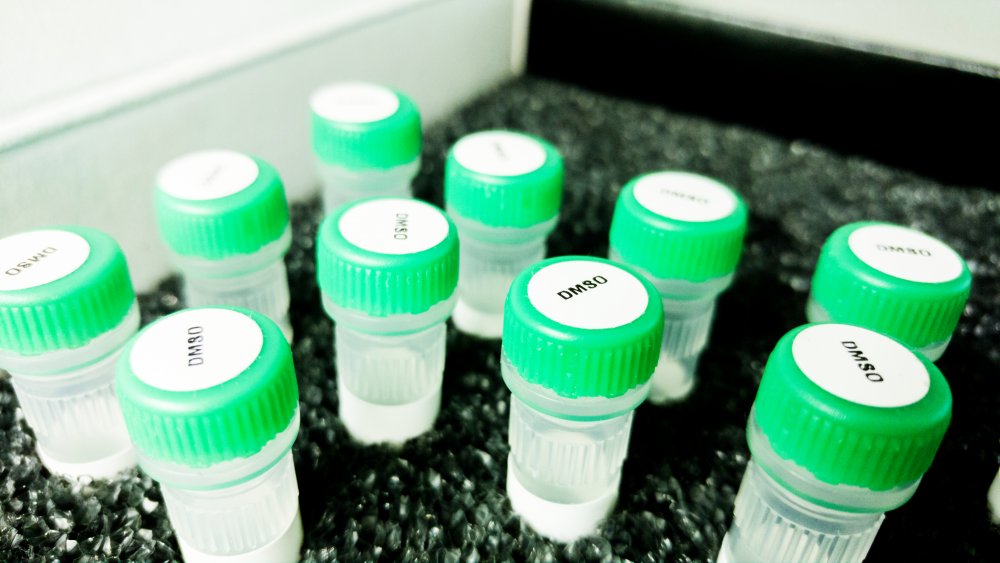The Truth About The Mysterious Toxic Lady
The life of a hospital Emergency Room staffer is never dull. There's always some new challenge on its way through the doors, and they're trained to be prepared for anything. Not only is theirs a life of constant pressure to perform quickly, they need to be accurate, too. Mistakes in the ER can have very bad consequences very rapidly.
But, as TV shows like House have taught us, sometimes the unexpected can arrive, and that ratchets up the pressure even more. How would you react in that situation? What if, even after years of training, something showed up on your metaphorical doorstep that was just completely outside of your experience?
What if it was something that, over 25 years later, people still couldn't quite make sense of? This was the experience of ER staffers at Riverside General Hospital one night in 1994. To this day, the mysterious Toxic Lady, Gloria Ramirez, still has not fully been explained.
Gloria Ramirez is admitted to the ER
Gloria Ramirez was your everyday citizen of Riverside, California. She had a husband and two kids and she was loved by many in her community, according to All That's Interesting. But that changed when, at the age of 31, she was diagnosed with late-stage cervical cancer. Just a mere six weeks later, on February 19, 1994, Ramirez complained of heart palpitations and shortness of breath.
Ramirez arrived at Riverside General Hospital at around 8:15 in the evening and was brought to trauma room one in the hospital's emergency department. She was awake, but her speech was difficult to understand, and sometimes downright incoherent. Her breathing was shallow and rapid, and her heartbeat was greatly elevated, according to Discover Magazine. Ramirez's heart was beating so fast that the chambers of her heart weren't even filling up with blood, causing her blood pressure to drop.
Until this point, everything with Gloria Ramirez was actually pretty normal, except that she was so young. Typically, patients with symptoms like Ramirez's were elderly, not 31-years-old. It wasn't until ER staff began treating Ramirez that things got very weird very quickly. Within moments, a relatively standard ER visit turned into one of the strangest events in medical history.
Gloria Ramirez's treatment begins
ER staffers began treating Gloria Ramirez's symptoms. First, they gave her several sedatives to calm her, like Valium and Ativan. This was standard procedure for a patient like Ramirez. They then followed this up with lidocaine and Bretylium to attempt to slow her heart. An Ambu-bag, the thing you see in movies that looks like an oxygen mask attached to a big, rubber ball, helped with Ramirez's shortness of breath, according to Discover Magazine.
Unfortunately, ER staff determined that these measures weren't helping as much as they'd like, so they made the decision to use a defibrillator. Ramirez's shirt was removed, and it was at this point that the staff noticed their first oddity: Ramirez's skin had an unidentified oily coating to it that no one recognized.
About this same time, multiple staffers complained of an odor, sometimes described as fruity and other times described as garlicky, which seemed to be coming from Gloria Ramirez's mouth, according to All That's Interesting. Neither the oily skin nor the smell was typical at all, even for a late-stage cancer patient. Despite this, ER staff rolled with the punches and continued treatment. This was merely the beginning, however, as things were about to turn into something none of Riverside General Hospital's ER staff had seen before or since.
The scent of blood
During this initial treatment, a registered nurse named Susan Kane began taking Gloria Ramirez's blood for further examination. After drawing a single syringe of blood, she noticed that something was very wrong. She smelled a very strong odor of ammonia, and was shocked to find that it was coming from the blood she had drawn from Gloria Ramirez, according to Discover Magazine. It was then that Kane started to feel faint.
Thinking quickly, Kane passed the syringe off to a respiratory therapist assisting in the ER that night, Maureen Welch, who also noticed the smell. Welch then passed the syringe to Julie Gorchynski, a third year medical resident. Gorchynski noticed the smell, too, but she also noticed something else — tiny, yellowish particles floating in the blood, according to All That's Interesting. While chemotherapy can give the body a chemical smell, it doesn't smell like ammonia or leave any sort of particles in the blood.
Dr. Humberto Ochoa, the lead doctor in the ER that night, also noticed the yellow particles in the blood, but couldn't tell what they were, besides very unusual. Nurse Susan Kane stood up, swayed, and fainted, just barely being caught by Dr. Ochoa. When she awoke, she said that her face was burning. At this point, Kane was placed on a gurney and wheeled out of trauma room one.
The evacuation
Julie Gorchynski, the medical resident who had noticed the yellow particles in Gloria Ramirez's blood, stepped out of the room to go sit at a nurse's station. She said she felt light-headed and queasy. Shortly after, another staff member noticed Gorchynski and asked if she was alright, at which point Gorchynski slid out of the chair and into the floor, passed out, according to Discover Magazine.
Gorchynski, like Susan Kane, was placed on a gurney and taken away from the trauma room. She also awoke shortly after passing out, at which point she displayed symptoms of muscle spasms (specifically, she would shake uncontrollably every few seconds) and apnea — involuntarily stopping breathing for several seconds at a time. At this same time, back in the trauma room, Maureen Welch, the respiratory therapist who had also handled Gloria Ramirez's blood, also fainted, according to All That's Interesting. She recalled hearing someone scream, and then nothing until she woke up, unable to control the movements of her arms and legs.
Other staffers in the room also complained of feeling ill. Dr. Humberto Ochoa, sensing something was very wrong, ordered staff and patients to evacuate the emergency department, moving into the parking lot instead, where they continued to examine patients and those who had been affected by what happened in trauma room one.
The skeleton crew who tried to save Gloria Ramirez
A small crew who weren't being affected by whatever was going on in trauma room one stayed behind to treat Gloria Ramirez, including Dr. Humberto Ochoa, according to Discover Magazine. Her vitals continued to fall, and the remaining team attempted CPR and further defibrillation, but it was no use. At 8:50 PM, just 35 minutes after she was admitted to Riverside General Hospital, Gloria Ramirez was declared dead.
After that, two staffers moved Ramirez's body into an isolation room out of an abundance of caution, but one of those two, Sally Balderas, also became ill and began vomiting and complaining of her skin burning. She, too, was put on a gurney and pushed into another room. Now there were four known staffers who were admitted to the hospital themselves, as well as an unnamed fifth.
A Riverside County hazmat team examined trauma room one top to bottom, but found no chemical leaks, dangerous gases, or, indeed, any evidence that anything had even been amiss, according to All That's Interesting. Everything showed as being completely clean. While the staff and hospital administrators were relieved to hear that no dangerous substances were found, the results were also concerning. If not a gas or chemical leak, what, exactly, had happened in that room?
The aftermath of the Toxic Lady
In all, 23 staffers who worked in or near trauma room one the night Gloria Ramirez died ended up feeling ill, and five ER staffers were hospitalized themselves. For those not admitted, the symptoms generally fell into a few categories: muscle spasms, feeling dizzy or nauseous, or respiratory trouble. A few reported burning sensations on their skin, according to Discover Magazine.
Sally Balderas, who helped move Ramirez's body, was hospitalized for 10 days, suffering from episodes of apnea. Julie Gorchynski, the medical resident who spotted the yellow particles in Ramirez's blood, got the worst of it and spent two weeks in intensive care. She, too, suffered apnea, but also developed hepatitis, pancreatitis, and avascular necrosis in her knees, which necessitated her using crutches for months after, according to Amusing Planet.
Initial investigations found that people who were closest in proximity to Gloria Ramirez, within two feet of her, were the most affected. This was doubly true for the staffers who handled her blood. They were, by far, the sickest. The Riverside Coroner's Office performed an autopsy on Ramirez (in a sealed environment) where they collected blood and tissue, but the results of this examination and any subsequent tests performed on Gloria Ramirez's remains have never been made public. Whatever they found, they soon began to request help from outside sources.
The official story of the Toxic Lady
On April 29, 1994, the coroner announced that Gloria Ramirez's cause of death was kidney failure related to cervical cancer, but they offered no explanation for the strange effects on hospital staff. The first outside group to investigate what happened that night at Riverside General Hospital was the California Health and Human Services Agency (CHHS). Since Gloria Ramirez's cause of death had been announced and a hazmat team had already ruled out gases or other outside toxins leaking into trauma room one, they focused on the staffers who got sick.
CHHS were the ones who discovered that staffers working closest to Gloria Ramirez and handled her blood got the sickest, but they also focused on other things they thought might be relevant to the case, according to Discover Magazine. Namely, they claimed that women on staff were more strongly affected, and people who skipped dinner felt sicker than those who had eaten. They also examined staff members' blood taken shortly after the event and found no signs of poisoning. All the samples came back clean.
On September 2, 1994, CHHS announced their findings: Mass sociogenic illness. That's the fancy word for mass hysteria, according to All That's Interesting. According to CHHS, no one had actually gotten sick at all, they had just smelled a bad odor and their minds went into overdrive from there. ER staffers who had shown actual physical symptoms after treating Gloria Ramirez, as well as Ramirez's family, were highly dissatisfied with these findings.
An outside consultant looked into what happened to Gloria Ramirez
Back in March of 1994, before the Riverside Coroner's Office had announced Gloria Ramirez's cause of death, they reached out to a third party, the Lawrence Livermore National Laboratory (LLNL), for additional assistance, according to Discovery Magazine. The LLNL examined Ramirez's remains and found a compound called dimethyl sulfone. Since the coroner's office didn't take things further than that, the LLNL reported its findings and moved on.
After the mass hysteria announcement in September, though, ER staffers who were affected that night reached back out to LLNL. Since it was several months after Ramirez's death and she had already been buried, LLNL seemed like the best choice for help, as they had already analyzed her remains months before and still had those results.
LLNL deputy director Pat Grant re-examined the previous analysis and noted the finding of dimethyl sulfone. It turned out this was incorrect. The chemical found was actually dimethyl sulfoxide (DMSO). Grant was familiar with this chemical because it was a folk remedy for aches and pains. DMSO had been studied for medical research in the 60s, but wasn't approved by the FDA and was considered a toxic substance, according to All That's Interesting. Diluted versions later got approved for treating interstitial cystitis, but to get the pure form of DMSO, you needed to go and buy it in hardware stores, where it was sold as a degreaser.
A significant clue to the Toxic Lady
Pat Grant and the LLNL began to develop a theory that Gloria Ramirez had been self-medicating with DMSO. Two of the notable effects of DMSO? Oily skin and a fruity, garlicky smell and taste. If this theory was correct, the DMSO that Ramirez had been taking as a pain reliever might have done something very unusual and effectively poisoned Riverside General Hospital staffers, according to All That's Interesting.
There was a problem, though. DMSO can be harmful, which is why it wasn't approved by the FDA in the 60s, but it's nowhere toxic enough to suddenly make over 20 people sick. Grant, a nuclear chemist by trade and not an expert in organic chemistry, looked into similar compounds to DMSO and found dimethyl sulfone (DMSO2), the chemical for which DMSO had initially been mistaken. It's chemically similar, but has an extra oxygen molecule. To add more fuel to the theory, they found that DMSO2 mixed with a blood substitute called Ringer's solution at room temperature caused the formation of white crystals, which might have appeared yellow in actual blood, according to Discover Magazine.
It seemed like Grant and LLNL were close to having a smoking gun on their hands, but like DMSO, DMSO2 is not a highly toxic substance capable of making nearly two dozen people ill within moments. They would need to go just a bit deeper and look at other, similar chemicals to DMSO and DMSO2.
A possible solution to the Toxic Lady
By adding two more oxygen molecules to DMSO2, it becomes dimethyl sulfate (DMSO4), a toxic nerve gas that had been trialed as a chemical weapon in war and gave those exposed to it symptoms nearly identical to those suffered by the staffers in trauma room one. Of the 20 types of symptoms reported by ER staff, DMSO4 could account for 19 of them, according to All That's Interesting. Only nausea and vomiting were not considered effects of DMSO4.
It seemed like a slam dunk, but there were still some problems. While the oxygen given to Gloria Ramirez when she was admitted at Riverside General Hospital could explain DMSO turning into DMSO2, there is no known process in which DMSO2 turns into DMSO4. While LLNL theorized that perhaps the temperature being too low in trauma room one or the electric shocks from the defibrillator somehow caused the chemical to change, this has not been replicated in any laboratory tests.
The Riverside Coroner's Office endorsed LLNL's findings as the most likely explanation, but other organic chemists in the field found the theory very unlikely, according to Discover Magazine. DMSO4 vaporizes at 370 degrees Fahrenheit, not in a slightly cool emergency room. In fact, there are records of people being exposed to the gas, but their symptoms took hours to appear, not minutes. On top of all that, the gas would have needed to somehow completely dissipate and leave no trace for the hazmat team to find.
The deadly cure
Toxic nerve gasses aside, if Gloria Ramirez had been self-medicating with DMSO, it's likely that it directly contributed to her death. Ramirez died of liver failure. If her kidneys had already been shutting down before taking DMSO, the chemical likely exacerbated things. It's also possible that Ramirez took so much DMSO that it caused her kidneys to fail in the first place. Either way, both scenarios lead to the same thing — Gloria Ramirez had a very large buildup of DMSO in her system. Her kidneys simply could no longer get rid of it.
Assuming LLNL's theory is correct, it's possible that the sheer amount of DMSO in her body turning into DMSO4 might have caused the very quick and acute symptoms experienced by the staff in trauma room one that night. But, again, this is unproven. No traces of DMSO4 were ever found in Gloria Ramirez's body, the blood samples of the ER staff, or in the room itself.
Ramirez's family disputed LLNL's findings, saying she never took DMSO, according to Discover Magazine. They planned on having their own autopsy done, but Ramirez's body wasn't released to them until two months after her death, according to The Washington Post. Not only were the tissues badly decayed, but the independent pathologist found that her heart and other organs were completely missing, and what remained seemed to have been cross-contaminated with fecal matter.
What really happened that night?
LLNL's findings have only ever been a theory, and the official explanation of what happened on February 19, 1994 remains mass hysteria. The Riverside Coroner's Office never made the results of their own testing public, and several key pieces of evidence, like the syringe of Gloria Ramirez's blood, disappeared and have never been found, according to Discover Magazine.
In fact, the Riverside Coroner's Office investigator who originally worked on the case committed suicide a month into the investigation of Ramirez's death, according to The Washington Post. This has led to some speculation about the possibility of a cover up. After all, why would Ramirez's organs be missing or contaminated with feces, something that any respecting examiner would take great pains to avoid?
A long-standing conspiracy theory alleges something very different happened. Allegedly, some staff were running their own meth lab on hospital property and smuggling it out in IV bags, according to The Straight Dope. The theory goes that one of these IV bags somehow ended up mixed in with the IV bags meant to be used on patients, and the ER staff, unaware of this fact, hooked it up to Gloria Ramirez. These meth fumes then seeped into the room when they drew her blood. Further rumors claim that Riverside County and Riverside General Hospital administration didn't want the bad press and covered the whole thing up. Naturally, there's zero evidence to back any of this up, but it is an interesting theory nonetheless.












